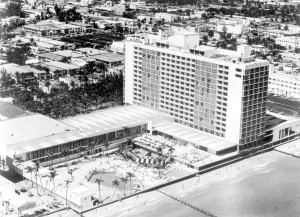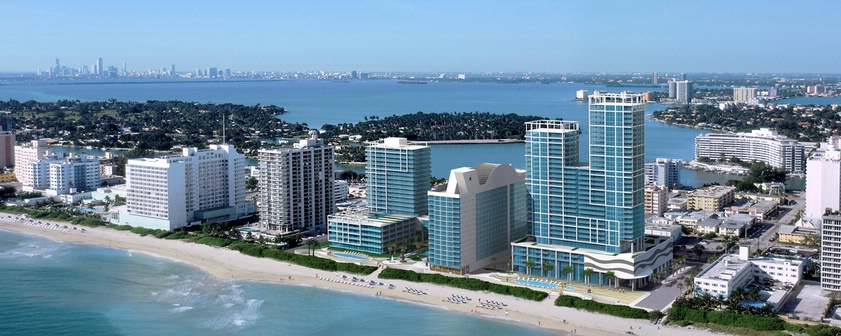
Eye-Stroll the sidewalk along Collins Avenue and 65th Street and it’s nearly impossible to ignore the bustling activity: cars zooming by, people patronizing busy shops, ethnic restaurants, and newly constructed luxury hotels. With such energy in the air, it’s also hard to believe that nearly 80 years ago, this area was virtually deserted. Although Miami Beach city limits reached 87th Street back in 1924 and wealthy industrialists owned estates along Indian Creek and the Atlantic Ocean up to 60th Street, a 1932 book called Along Greater Miami’s Sun-Sea-Ara, notes that a mere three buildings sat on the sand between 62nd and 71st Streets. They were the Gulf Stream Apartments, east of Collins Avenue, just below 63rd Street; the Deauville Casino (as in swimming pool, not gambling establishment) at 67th Street; and the Deauville Bungalows at 71st Street.
What a difference a couple of decades made. After World War II, the advent of air conditioning in buildings and the ability for hotel owners to allow live entertainment to take place on their premises (an ordinance to protect local nightclubs once forbade such a practice) soon ushered in a lively glamorous era on Miami Beach remembered so fondly by mid-century tourists and residents alike. The Sherry Frontenac, designed by Henry Hohauser, was the first major hotel built after the War.
Just a decade later, in 1957, the dazzling Deauville hotel, designed by Melvin Grossman, was built on the site of the old bathing casino which in 1926 had featured the state’s largest swimming pool. Still functioning today, the 12-story, 500-plus room hotel was one of the early full-service resorts featuring onsite restaurants, nightclubs, boutiques, a beauty salon, and even an ice skating rink. It is perhaps most famous for hosting a performance by the Beatles in 1964 and housing them as well.
The Deauville’s immediate neighbor to the north, the Carillon hotel, also opened in 1957. Designed by the architect Norman Giller, the hotel featured a sleek pedestal and a 14-story tower fronted by a striking glass curtain wall. Part of the hotel was demolished in 2002 for a condo conversion that didn’t materialize. The tower, however, remained. In 2004 the celebrated resort Canyon Ranch stepped in with plans for a condo-hotel project featuring a spectacular spa, of course.
The partial destruction of the Carillon and the demolition of the Bel Aire Apartments woke preservationists to the fact that a 10-block stretch approximately from 60th to 70th Streets contained a dense concentration of Miami Modern buildings along with a couple of Neoclassical Revival and Streamline Moderne structures. These hotels, motels, and stores were designed by a cavalcade of locally prominent architects such as Roy France, Albert Anis, and L. Murray Dixon. Activism spurred the City of Miami Beach into action. And in 2004, the North Beach Resort Historic District was established. It begins at 65th Street and runs to 71st Street, encompassing all but one of the structures on the east side of Collins Avenue and buildings on both sides of Collins Avenue at 63rd Street.
The historic district can be admired and experienced from many perspectives: from the sidewalk that runs along Collins Avenue; from inside of the hotels themselves; and from the beach, by walking along the beachwalk pedestrian path that runs behind the hotels and stretches from Allison Park to the south side of North Shore Open Space Park.
Canyon Ranch Living is now open for business, adding a new vitality to the neighborhood. Truly “living” as its name suggests. Appropriate for an area that has had many lives over the years and whose future holds so much promise.


